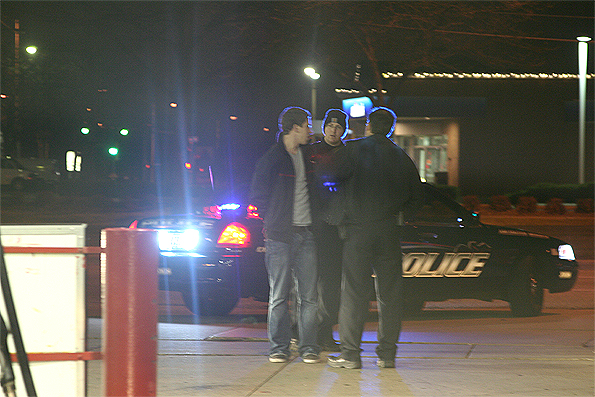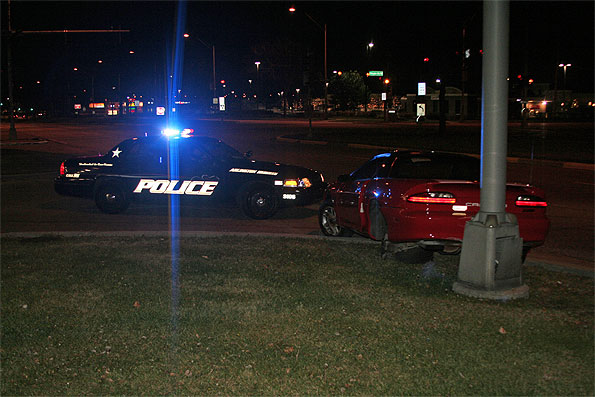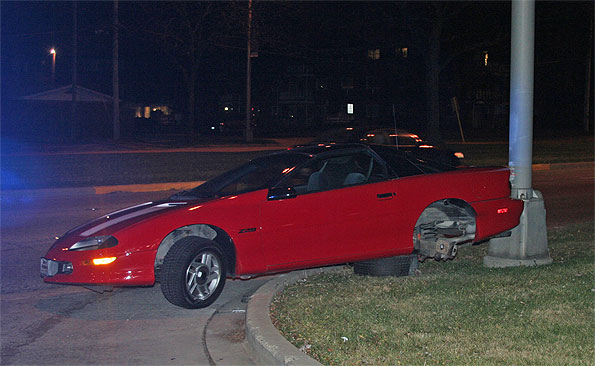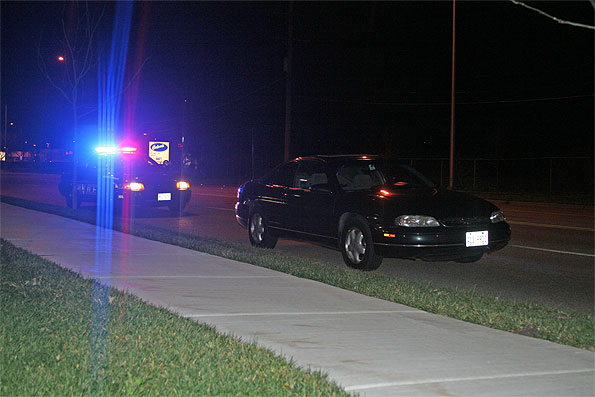
Police arrest a young male driver of a red Chevy Camaro after the car spun out and crashed into a light pole on Palatine Road, just west of Arlington Heights Road.
Arlington Heights police arrested an alleged DUI driver about 2:10 a.m. Saturday after a driver crashed his red Chevy Camaro while he drove out of an exit at the Speedway gas station at Arlington Heights Road and Palatine Road. Police were already in the area when the diver lost control and spun around and hit the back end of the camaro with slight force into a large light pole. No injuries reported.
The driver was checked with a PBT and arrested about 2:10 a.m. Saturday. He was transported to a police holding area. His Camaro, which appeared to have been recently purchased with no license plates on the car, was towed to a police holding area. The left wheel also broke off the axle with the force of hitting the curb at the gas station exit.

Alleged DUI driver lost control while exiting Speedway gas station.

Broken rear axle after alleged DUI crash.
Police arrested a second driver on the south side of town at about 2:33 a.m. Saturday on Algonquin Road, just east of Busse Road by Moretti’s and Culver’s. The driver was transported in custody to Arlington Heights Police Department Headquarters.

Police wait for DUI hold tow on Algonquin Road, just east of Busse Road.
Police and firefighter/paramedics also responded to a bicyclist down on a lawn near Kenicott Avenue and Maude Avenue about 4:47 a.m. The man on the back was apparently intoxicated and lost control of his bike.
Get updates from The Cardinal CRIME BLOG ‘Plus’ on Facebook. Just ‘LIKE’ the ‘Arlington Cardinal Crime & Forensics’ Page (become a fan of our page). The updates cover all posts in the 24/7 Crime Alerts! and sub-categories. See all of The Cardinal Facebook fan pages at Arlingtoncardinal.com/about/facebook …
Reasonable Suspicion to Investigate A Driver for DUI
Driving under the influence of alcohol to the extent that mental or motor skills are impaired is illegal in all jurisdictions in the United States. There are several traffic situations when a police officer comes into contact with a driver, and then follows procedures which lead to a DUI arrest:
- The driver has been involved in an automobile accident and the officer has responded to the accident scene and is conducting an investigation.
- The driver has been stopped at a sobriety checkpoint (also known as roadblocks).
- The police have received a report, possibly via 9-1-1 from an anonymous citizen, that a driver appears to be DUI. The police officer usually verifies the erratic driving before makeing the traffic stop.
- The patrol officer has observed erratic, suspicious driving, or a series of traffic infractions indicating the possibility that the driver may be impaired. This is by far the most common reason for stopping a suspect.
- A police officer has stopped a vehicle for a lesser traffic offense and notices the signs of intoxication.
The following list of DUI symptoms, from a publication issued by the National Highway Traffic Safety Administration (DOT HS-805-711), is widely used in training officers to detect drunk drivers. After each symptom is a percentage figure which, according to NHTSA, indicates the statistical chances (%) through research, that a driver is over the legal limit.
- Turning with wide radius, 65
- Straddling center or lane marker, 65
- Appearing to be drunk, 60
- Almost striking object or vehicle, 60
- Weaving, 60
- Driving on other than designated roadway, 55
- Swerving, 55
- Slow speed (more than 10mph below limit), 50
- Stopping (without cause) in traffic lane, 50
- Drifting, 50
- Following too closely, 45
- Tires on center or land marker, 45
- Braking erratically, 45
- Driving into opposing or crossing traffic, 45
- Signaling inconsistent with driving actions, 40
- Stopping inappropriately (other than in lane), 35
- Turning abruptly or illegally, 35
- Accelerating or decelerating rapidly, 30
- Headlights off, 30
If the officer observes enough to have a reasonable suspicion to legally justify a further detention and investigation, he will ask the driver to step out of the vehicle.
Reasonable suspicion requires less evidence than probable cause, but more than a mere hunch. A rule of thumb is that reasonable suspicion requires 25 % proof, and probable cause requires more than 50 % statistical chance. Therefore, if there is probable cause for arrest for DWI, as suggested by the research and examples used above, then there is reasonable suspicion to stop a driver.
Investigation
A police officer typically approaches the driver’s side window and asks some preliminary questions. During this phase of the traffic stop the officer will note if they detect any of the following indicators of intoxication
- odor of an alcoholic beverage on the driver’s breath or in the car generally
- slurred speech in response to the questioning
- watery, blood shot, and/or reddish eyes
- flushed face
- droopy eyelids
- difficulty in understanding and responding intelligently to question
- fumbling with his or her driver’s license and registration
- the plain-view presence of containers of alcoholic beverages in the vehicle.
- admission of consumption of alcoholic beverage

